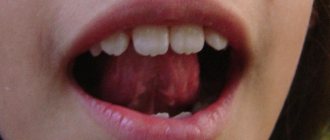Ronchopathy is being treated and this is already good. In addition, you can get rid of it in a very cheap way - with the help of tongue gymnastics. By choosing effective exercises, they will prevent its return after therapy. This technique is also suitable for preventive measures. A complex for the tongue is exactly what you need to do every day, then there will be a lasting effect.
So, with the help of physical education, you can significantly strengthen the muscles of the tongue, which your illness will not like. Of course, we are not talking about a complete treatment of apnea - what we offer is only part of a large therapeutic complex. Half an hour of exercise a day for a month, and you and your household will like the results.
Correct tongue position - why is it important?
For the correct formation of a bite and coherent speech, the correct functioning of all elements of the dental system is important.
The position of the tongue also plays an important role. Under normal conditions, the tongue should exert slight pressure on the upper row of teeth, which contributes to the formation of a correct bite in childhood. The physiological position of the tongue has the following positive effects:
- The development of the upper jaw is stimulated, both in length and width.
- Blood microcirculation in the nasopharynx area improves. This helps strengthen local immunity, which is important, in particular, for protection against respiratory infections.
- Balance improves, which is a prerequisite for the formation of correct posture.
- The normal tone of the facial muscles is maintained in a calm state.
Cost of tongue massage at Dial-Dent. Specialist in speech therapy massage.
At the Family Dental Tongue Massage or speech therapy massage, speech therapist-myofunctional therapist Tatyana Borisovna Tsukor is engaged. Graduated from Moscow Pedagogical State University. Lenin. Work experience more than 15 years. Speech therapist teacher of the highest qualification category. Laureate of the competitions “Heart given to children 2008” and “Heart given to children 2010”.
The cost of a session with a speech therapist is 3,500 rubles. The duration of the session is from 30 minutes to 50 minutes depending on the task and the age of the patient. If necessary, the session also includes speech therapy massage.
Being a unique speech therapist who has been collaborating with dentists for a long time and successfully, Tsukor T.B. conducts training courses for both orthodontists and speech therapists. The course covers all aspects of speech therapy massage. Of course, every orthodontist should know about the capabilities of such a powerful tool as speech therapy massage. Training is carried out both as part of presentations at congresses, and individually or in small groups.
Our speech therapist also conducts classes via Skype. The cost of such a lesson is 2500 rubles. As you understand, speech therapy massage cannot be done via Skype, so if you need a massage, you will still have to come to Dial-Dent.
You can make an appointment with the Family Dental speech therapist Tatyana Borisovna Tsukor by calling the clinic +7-499-110-18-01 or using the form on the website. You can ask questions about speech therapy, as well as massage training, to T.B. Zukor on her page in.
Tongue position - what does it affect?
The correct position of the tongue is the key to a physiological bite, as well as the absence of problems with swallowing, chewing and speech. Let's look at the main negative consequences that arise when the tongue is positioned incorrectly.
If the tongue is pushed back:
- Swallowing disorder is a disorder in the synchronization between swallowing and breathing.
- Pulling the lower jaw back.
- Dysfunction of the auditory tube.
- Violation of voice formation.
If the tongue is moved forward:
- Swallowing disorder.
- The lower jaw is pulled forward.
- Violation of voice formation.
- Curvature of teeth, especially the front ones.
- Protrusion of the tongue forward.
- Decreased lip tone (up to complete loss).
- Excessive tension transmitted to certain muscles and joints of the dental system.
Symptoms that occur due to improper tongue position include:
- violation of nasal breathing;
- swallowing disorder;
- speech defects;
- neuromotor development disorder;
- symptoms from ENT organs;
- malocclusion and other dental problems;
- dysfunction of the temporomandibular joint (TMJ);
- emotional disturbances.
Exercises to normalize breathing function
Exercise No. 1 Full breathing. Take a long breath through your nose. During inhalation, the abdomen “inflates”, then the chest expands. When you exhale (through the nose), on the contrary, the volume of the chest first decreases, then the stomach retracts.
Exercise No. 2 Chest breathing. Exhale. Take a long breath through your nose. At this time, the chest expands and the stomach retracts. When you exhale (through the nose), the stomach retracts.
Exercise No. 3 Abdominal breathing. Exhale. Take a long breath through your nose. At this time, the stomach protrudes. When you exhale (through the nose), the stomach retracts.
Exercise No. 4 The skill of full, extended exhalation. Walk at an average pace. Inhale and exhale only through the nose. Inhale for three steps, exhale for four steps. After three to four days, the duration of exhalation should be increased by one count (5,6, etc.)
Exercise No. 5 Inhale and exhale alternately through one nostril (press the second nostril tightly with your finger).
Why is the tongue positioned incorrectly?
There are several reasons that have a direct impact on the position of the tongue in the oral cavity:
- Nasal breathing disorder . This causes the tongue to move downwards. Such changes are necessary to facilitate oral breathing. Let us remember that mouth breathing, in turn, contributes to the formation of malocclusion. Therefore, parents need to closely monitor the respiratory condition of their children.
- Short bridle . In this case, the tongue is “sandwiched” by the short frenulum in a lowered position. Physically, the tongue is not able to fully press against the palate (the position of the tongue is physiologically correct).
- Curvature in the cervical spine . Dysfunction of the cervical spine has a direct impact on the position of the tongue.
- Disorders of muscles and nerves . Dysfunction of certain nerves and muscles of the maxillofacial area can cause improper tongue position. For example, this applies to the work of the glossopharyngeal and hypoglossal nerves, as well as the styloid-glossus and palatoglossus muscles. Disorders of the functions of these nerves and/or muscles lead not only to incorrect tongue position, but also to impaired swallowing and breathing.
The position of the tongue is also influenced by several factors, namely:
- Factors of intrauterine development - multiple pregnancy, uterine anomalies, uterine hypertonicity and others.
- Hereditary factors.
- Injuries to the fetus during childbirth.
- Prematurity.
- Artificial feeding. If a child is forced to be bottle-fed, then the development of the bite and dental system must be carefully monitored.
- Late introduction of solid food (when the child has been on a liquid diet for a long time).
- Bad habits – thumb sucking, object sucking, cheek biting, prolonged sucking of pacifiers.
- Premature loss of baby teeth.
- Frequent respiratory diseases (in particular, chronic sinusitis, enlarged adenoids and other diseases).
Teeth marks on the tongue are one of the signs of improper tongue position
Exercises to normalize the function of lip closure
Exercise No. 1 Pull your lips forward, close them, draw a tube, and stretch them wide.
Exercise No. 2 Pull your lips forward, close them, depict a mouthpiece, a proboscis.
Exercise No. 3 Close your lips, puff out your cheeks, slowly squeeze the air through your clenched lips with your fists.
Exercise No. 4 Close your lips, then move them alternately to the right and left.
Exercise No. 5 Close your lips, blow air under your upper lip, then under your lower lip.
Exercise No. 6 Place bent little fingers in the corners of the mouth, do not close your lips, spread your fingers slightly to the sides, close your lips.
Exercise No. 7 Blow out a stream of air with force (“a breeze is blowing,” let’s put out the candle,” “let’s make a storm,” etc.).
Types of tongue malposition
There are 7 options for tongue position. The first one is correct, and all the others are variants of the incorrect location of the organ. Let's take a closer look at them.
Option 1 – physiologically correct tongue position
The palatal position of the tongue is considered correct1. The tongue at rest is pressed against the palate and is located behind the upper incisors. With this arrangement of the organ, a physiologically correct bite is initially formed (unless, of course, there are other reasons and factors for the development of pathological occlusion). In this case, for the formation of a correct bite, the general muscle tone of the face, the work of the temporomandibular joint and other elements of the dental system are also important.
Option 2 – loose fit to the palate
In this case, the tongue rests approximately 0.5 cm above the lingual tubercles. Also, the tongue may drop down by about 0.5-0.8 cm. Under such circumstances, the organ is not pressed tightly against the palate.
When swallowing in this case, the tongue will rest against the upper or lower incisors. This leads to tension in the muscles of the lower lip, which in turn tilts and crowds the lower teeth.
Option 3 - the tongue passes between the molars
With this arrangement, the tongue covers the lingual cusps. The tone of the lower lip is impaired, which leads to the formation of a deep bite. In this case, the lower teeth often crowd together due to lack of space.
It is noteworthy that over time, the severity of a deep bite may increase, and the lower jaw may shift to a posterior position. In this case, the person complains of limited mobility of the lower jaw (in particular, when opening the mouth).
Option 4 – the tongue covers the buccal and lingual cusps
If the tongue covers the buccal and lingual cusps of the lower molars and/or premolars, then in childhood this leads to problems with teething. The tongue puts pressure on the buds of baby teeth, preventing the latter from erupting. In the future, this may lead to disruption of the formation of the roots of permanent teeth. There is even a risk of tooth root resorption, which leads to adentia (tooth loss).
With the 4th variant of the tongue position, the muscle tone of the lips decreases. In such a situation, an inadequate load is placed on the temporomandibular joint, which leads to disruption of its function.
Option 5 – low tongue position
When the tongue is low, it becomes stiff. Often the tip and middle part of the tongue have increased tone. For this reason, such a language visually appears to be overly large. However, it is not. The tongue is of normal size, but the volumetric effect creates tone.
The low position of the tongue has a significant impact on the dental system, in particular the lower jaw. For this reason, excessive development of the lower jaw (macrognathia) with the formation of a mesial bite is possible. There is also a danger of underdevelopment of the upper jaw, which also forms a mesial bite.
When the jaw moves forward, the functioning of the jaw joints is also disrupted. This leads to characteristic clicking and pain when trying to open the mouth.
Option 6 – tongue between the upper and lower incisors
Often, with this position of the tongue, the orbital muscles of the mouth are weakened and the masticatory tone of the muscles is reduced. This is another option for the “low” location of the organ. Most often, in the 6th position, the tongue is not active enough, which leads to the development of speech defects. The distortion of whistling sounds is especially noticeable.
If with this arrangement the tone of the masticatory muscles is also disturbed, then lengthening of the face is possible, as well as discomfort and pain in the jaw joints. This is due to a violation of the distribution of loads on the facial muscles.
Option 7 – lateral position
Most often, the reason for this position of the tongue is bad habits (thumb sucking, biting nails, pens, etc.). Impaired innervation is another reason for lateral displacement of the tongue.
When the tongue is in a lateral position, swallowing is impaired. The tongue will put pressure on the side of the dental system where it deviates. This leads to uneven development of the jaws.
What causes dystonia?
Since tongue spasms are not a disease, but only a symptom, it can be difficult to name a specific cause for this phenomenon. Experts distinguish three types of dystonia: primary, or idiopathic (sudden spasms of unknown etiology), hereditary (through at least one parent) and secondary, or symptomatic (acquired as a result of illness or injury). Both Russian and foreign scientists believe that all three types of dystonia are associated with the same part of the brain, the basal ganglia, which control muscle contraction.
Training to improve the situation
It is possible and necessary to correct the position of the tongue. Myofunctional therapy has been developed for this purpose. It is used for both therapeutic and preventive purposes. The advantages of this treatment are that it can be performed at any age and at any stage of orthodontic treatment. In addition, mewing does not require special skills or experience. Myofunctional orthodontics specialists will simply show you exercises that need to be performed regularly. The patient’s task is to perform the complex in strict accordance with the doctor’s recommendations.
Here are some common exercises that will help correct the position of your tongue:
- Place your lips behind your lower teeth, press your tongue to the roof of your mouth, and tighten your chin. Hold this position for 5 seconds, then relax your muscles. Repeat 10 times.
- Place your tongue behind your upper teeth, lengthen your chin and tense your lower jaw and hold for 10 seconds. Repeat 10 times.
- The tongue must be placed in the palatine cavity and tense. Stay in this position for 10 seconds, then relax. Repeat 10 times.
- The starting position is the same as in the previous exercise. Now try to swallow saliva without using the muscles of your cheeks and lips. Only the muscles of the tongue should work. This exercise will be difficult for you at first, but every time you do it you will notice progress. Repeat 10 times.
- The starting position is the same as the previous exercise. Tighten your tongue and smile. Then use your index fingers to press on the corners of your mouth, trying to hold back your smile. After 10 seconds you can relax. Repeat 10 times.
- Pull your tongue forward as far as possible, trying to reach your chin. Hold for 5 seconds. Repeat 15 times.
- Extend your tongue, trying to reach the tip of your nose. Hold for 5 seconds. Repeat 15 times.
Who does tongue massage? Who has special knowledge for this?
Despite the fact that the word massage implies the participation of a massage therapist in the process, in the case of speech therapy massage this is not the case! Speech therapists provide speech therapy massage! But not all speech therapists are ready and able to perform massage. Typically, a speech therapist who has gained experience and understands that many problems cannot be solved without speech therapy massage receives additional education on the topic of “speech therapy massage.” After training and receiving a special document, a speech therapist is considered a tongue massage specialist.
It should be added that you can do tongue massage yourself, for example, when a mother does basic techniques to her child. But all the same, it is better to entrust the appointment of massage and control over its effectiveness to an experienced speech therapist-myofunctional therapist! What distinguishes a simple speech therapist from a speech therapist-myofunctional therapist is that the latter understands in more detail and is able to work with the muscles of the articulatory apparatus and masticatory organ.
FAQ
Will I be able to correct my malocclusion if my tongue position remains incorrect?
Modern orthodontics has a wide range of methods for correcting malocclusion. At the same time, bite correction must be comprehensive. A prerequisite is the elimination of all causes and factors leading to the formation of malocclusion. This also applies to correcting the position of the tongue.
Will myogymnastics help correct the situation?
Yes. Exercises will help correct the position of the tongue. But sometimes exercise is not enough. Additionally, orthodontic treatment to correct the bite is required. In some cases, surgery is needed.
Should the tongue rest on the teeth?
No, it should be located behind the teeth.
Exercises to normalize breathing function
Exercise No. 1 Full breathing. Take a long breath through your nose. During inhalation, the abdomen “inflates”, then the chest expands. When you exhale (through the nose), on the contrary, the volume of the chest first decreases, then the stomach retracts.
Exercise No. 2 Chest breathing. Exhale. Take a long breath through your nose. At this time, the chest expands and the stomach retracts. When you exhale (through the nose), the stomach retracts.
Exercise No. 3 Abdominal breathing. Exhale. Take a long breath through your nose. At this time, the stomach protrudes. When you exhale (through the nose), the stomach retracts.
Exercise No. 4 The skill of full, extended exhalation. Walk at an average pace. Inhale and exhale only through the nose. Inhale for three steps, exhale for four steps. After three to four days, the duration of exhalation should be increased by one count (5,6, etc.)
Exercise No. 5 Inhale and exhale alternately through one nostril (press the second nostril tightly with your finger).
Exercise No. 6 Exhale. Pinch your nose with your fingers. Slowly count out loud to 5, then take a deep breath and exhale through your nose.
Exercises to strengthen the pharyngeal muscles
Exercise No. 1 Alternately tilt your head back as much as possible, leaning forward.
Exercise No. 2 Throw your head back. In this position, alternately tilt your head towards the right and left shoulder.
Exercise No. 3 Throw your head back, in this position alternately turn your head, without releasing your chin, to the right, then to the left.
Exercises to normalize breathing function
Exercise No. 1 Full breathing. Take a long breath through your nose. During inhalation, the abdomen “inflates”, then the chest expands. When you exhale (through the nose), on the contrary, the volume of the chest first decreases, then the stomach retracts.
Exercise No. 2 Chest breathing. Exhale. Take a long breath through your nose. At this time, the chest expands and the stomach retracts. When you exhale (through the nose), the stomach retracts.
Exercise No. 3 Abdominal breathing. Exhale. Take a long breath through your nose. At this time, the stomach protrudes. When you exhale (through the nose), the stomach retracts.
Exercise No. 4 The skill of full, extended exhalation. Walk at an average pace. Inhale and exhale only through the nose. Inhale for three steps, exhale for four steps. After three to four days, the duration of exhalation should be increased by one count (5,6, etc.)
Exercise No. 5 inhale and exhale alternately through one nostril (press the second nostril tightly with your finger).
Exercises to normalize breathing function
Exercise No. 1 Full breathing. Take a long breath through your nose. During inhalation, the abdomen “inflates”, then the chest expands. When you exhale (through the nose), on the contrary, the volume of the chest first decreases, then the stomach retracts.
Exercise No. 2 Chest breathing. Exhale. Take a long breath through your nose. At this time, the chest expands and the stomach retracts. When you exhale (through the nose), the stomach retracts.
Exercise No. 3 Abdominal breathing. Exhale. Take a long breath through your nose. At this time, the stomach protrudes. When you exhale (through the nose), the stomach retracts.
Exercise No. 4 The skill of full, extended exhalation. Walk at an average pace. Inhale and exhale only through the nose. Inhale for three steps, exhale for four steps. After three to four days, the duration of exhalation should be increased by one count (5,6, etc.)
Exercise No. 5 Inhale and exhale alternately through one nostril (press the second nostril tightly with your finger).








